Project Schedule Quality 101: 14 Ways to Improve Schedule
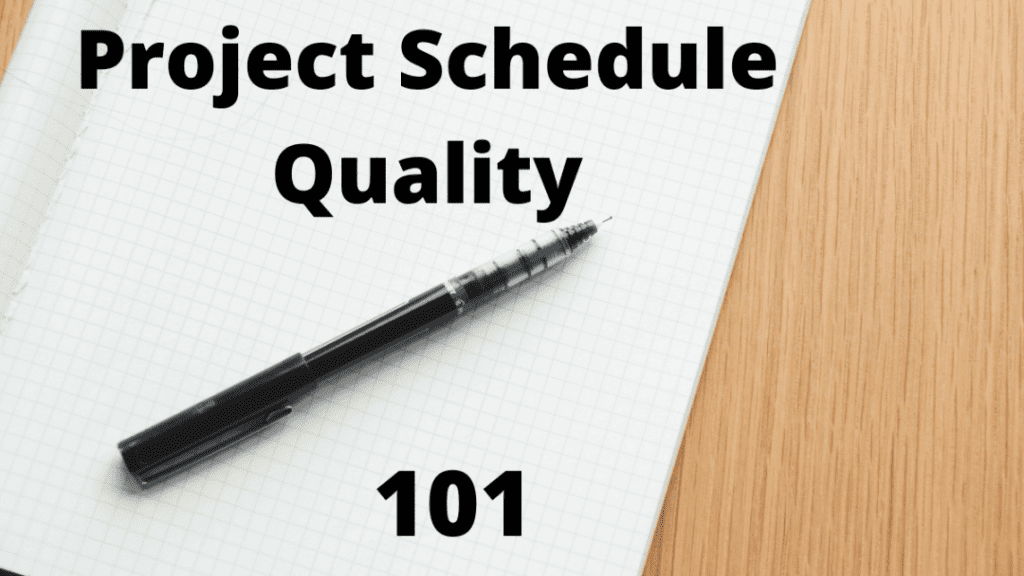
Welcome to the first chapter of our new blog series: Project Schedule Quality 101
I’ve been thinking a lot about schedule quality lately as I’m integrating one heck of a project schedule that involves 5 different vendors, 3 project managers, and a lot of scope. I’ve received multiple vendor schedules and have been adding the integration tasks to my schedule.
How do you know if your or vendor’s schedules are good?
How do you measure project schedule quality if you received another project manager’s schedule from another vendor or team member? Many PMs rely on experience and look for a few schedule characteristics such as assigned resources, milestones, accurate dates, and a logical sequence of tasks. Your organization may even have a formal checklist to define schedule quality. I’ve used other online project management software tools, which automatically update and forecast the schedule.
A few of my favorite poor schedule quality checks include:
- Summary tasks with a predecessor
- Summary tasks with resources assigned
- Milestone tasks with a duration greater than zero
- Tasks missing resource assignments
- Tasks missing a project baseline
- Resource allocation is realistic
These are just a few characteristics I look for in vendors and even my project schedules.
Wouldn’t it help if there was a formal project schedule quality guideline?
It always helps to have a formal guideline and the Defense Contract Management Agency’s (DCMA) provides a 14-point assessment that can be applied to evaluate project schedule quality. The DCMA is a Department of Defense organization that works with suppliers to manage the U.S. Federal Government projects.
The DCMA only evaluates valid tasks in the project schedule. Summary tasks, subprojects, zero-duration tasks, and formal milestone tasks are removed from the analysis. The DCMA provides 14 schedule quality checks, which I’ve divided into project schedule development and project schedule management categories.
The 14 DCMA project schedule quality checks include:
Schedule Development Quality Checks
- Project Schedule Quality Check #1: Missing Logic
- Project Schedule Quality Check #2: The Lags Check
- Project Schedule Quality Check #3: The Leads Check
- Project Schedule Quality Check #4: Relationship Type Check
- Project Schedule Quality Check #5: The Hard Constraints Check
- Project Schedule Quality Check #6: The High Float Check
- Project Schedule Quality Check #7: The Negative Float Check
- Project Schedule Quality Check #8: The High Duration Check
- Project Schedule Quality Check #9: The Invalid Dates Check
- Project Schedule Quality Check #10: The Resources Check
Schedule Management Quality Checks
- Project Schedule Quality Check #11: The Missed Tasks Check
- Project Schedule Quality Check #12: The Critical Path Check
- Project Schedule Quality Check #13: The Critical Path Index
- Project Schedule Quality Check #14: The Baseline Execution Index
Let’s dive in and closely examine these project schedule quality checks.
Project Schedule Quality Check #1: Missing Logic
The missing logic check determines if any tasks lack a successor or predecessor. Ideally, all activities should have one predecessor and a successor task in the schedule except for the first and last tasks.

In actual practice, you will have tasks that start on a given date and don’t necessarily have a predecessor. The task may be related to an external vendor providing a deliverable or product. The lesson learned is to avoid orphaned tasks as it becomes difficult to determine a project’s critical path. A quality schedule should not have more than 5 percent of its functions missing the predecessor and successor logic.
Project Schedule Quality Check #2: The Lags Check
A lag is an intentional delay in the project schedule. In Microsoft Project, a 2-day lag looks like this:

By minimizing the use of lags, the critical path calculation is improved. A quality schedule should have fewer than 5 percent of the tasks with lags. Instead of using a lag, project managers should add another task for the lag duration, and during project execution, this delay can be reduced if needed.
Project Schedule Quality Check #3: The Leads Check
A lead can be used to pull a task ahead of the schedule. The Leads check looks for negative lags, otherwise known as leads, in the project schedule. Leads don’t make much sense to me, as most schedules should follow a Finish-Start relationship. In this example, the preceding duration should be smaller if a task starts earlier.

You want to be able to calculate the critical path quickly, but adding leads can negatively impact the project’s critical path. I’ve never used a lead in practice, although I have used lags to “tweak the schedule.”
Project Schedule Quality Check #4: Relationship Type Check
90 percent of all the tasks in the project schedule should have Finished to Start relationships. Microsoft Project provides multiple relationship types, including Finish to Start, Start to Start, Finish to Finish, and Start to Finish tasks.
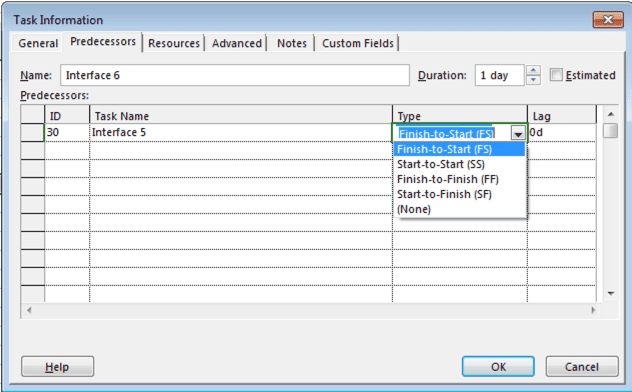
The default relationship type is a finish-to-start relationship. Using finish-to-start relationships provides a logical flow to the schedule. Although there may be situations where a start-to-start relationship is needed, I still prefer to keep it in the schedule.
Project Schedule Quality Check #5: The Hard Constraints Check
Project managers should build a dynamic schedule. If the duration on the critical path changes, then you’d expect the finish date to adjust by the same duration. However, I’ve seen a lot of project schedules that follow a “pick a date” project management approach. The “pick a date” often results in a hard constraint that indicates a task must finish on or start no later than a specific date.
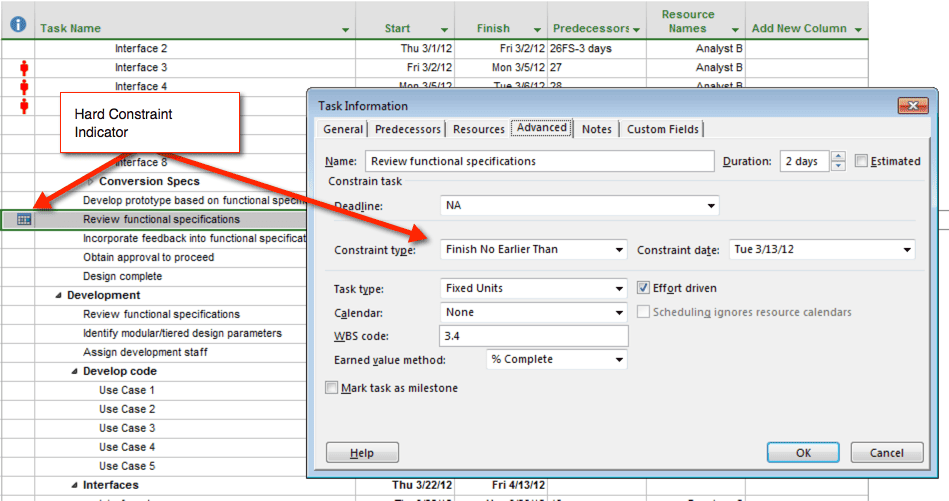
In Microsoft Project, a hard constraint is any task with a Must Finish On, Must Start On, Start No Later Than, or Finish No Later Than constraint. You ideally want your schedule to be dynamic so date changes flow easily when the project is updated. In a constraint-based schedule, you’ll receive that annoying warning message if the date exceeds the constraint.
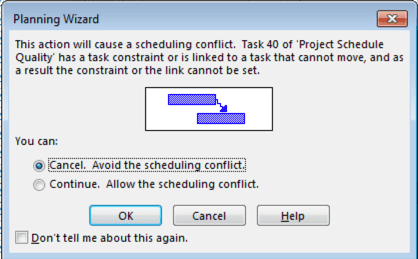
In actual practice, I even have hard-constrained tasks. This usually occurs when I have an external vendor deliverable due. A solution to the hard constraint is to use a deadline to act as an alert to the project schedule. If a vendor provides a deliverable, I could change the actual start date and schedule the task from that point forward. Ideally, a quality schedule will not have more than 5% of its functions with complex constraints.
Project Schedule Quality Check #6: The High Float Check
Schedule float is the slack in the project schedule. It represents the total time a task can be delayed without causing a delay to the project. The high float check looks for functions with a total float greater than 44 working days. If a task has more than 44 days of float, a predecessor or a successor is missing from the project schedule.

If 5% of your schedule consists of high-float tasks, you must review any missing predecessors.
Project Schedule Quality Check #7: The Negative Float Check
The Negative Float Check identifies tasks with a total float of less than zero. This check helps identify any tasks that may impact the completion of other tasks in the schedule. There should be zero tasks with negative float.
Project Schedule Quality Check #8: The High Duration Check
A best practice in project schedule management is to break down tasks into tasks with no longer than 2 weeks. I’ve seen some project schedules with task durations of several weeks or months. When I see these higher durations, it indicates that the project manager needs to decompose the tasks into greater detail. The high-duration check looks for functions with a baseline duration greater than 44 days.

Ideally, the project schedule should not include any high-duration tasks. However, 5% is an acceptable schedule quality guideline.
Project Schedule Quality Check #9: The Invalid Dates Check
The invalid date check looks for invalid forecast dates and actual dates based on the project status date.
Invalid Forecast Date
The invalid forecast date assumes an unfinished task cannot start or finish BEFORE the project status date. A task should have a forecast start and finish date relative to the project status date in the future. You’ll likely find many incomplete tasks if the forecast start and finish dates need to be updated. In Microsoft Project, you must reschedule incomplete work to adjust the forecasted start and finish dates. If you’re using Microsoft Project, you must reschedule the unfinished work.
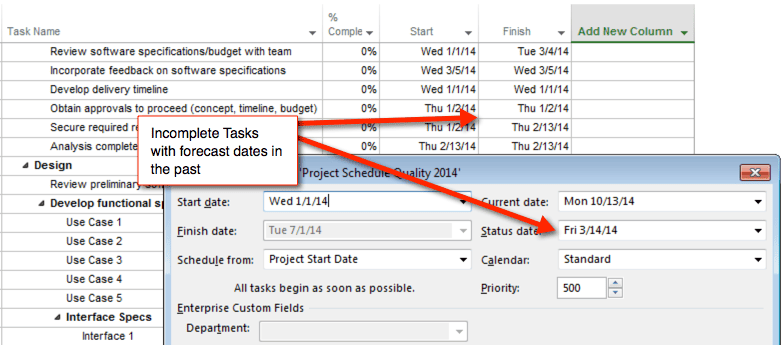
Invalid Actual Date
The invalid actual date check looks for tasks with an actual start or finish date AFTER the project status date. A project schedule shouldn’t have an actual start or actual finish date in the future. All actual start and finish dates should be less than or equal to the project status date.
Zero tasks should fall into this category in a quality schedule, as accurate dates are essential for solid project schedule management.
Project Schedule Quality Check #10: The Resources Check
The resources check identifies all the tasks that do not have resources assigned in the project schedule. When the project schedule grows beyond a handful of tasks, it is easy to forget resources. Resources need to be identified for individual tasks for proper accountability and scheduling. It’s impossible to resource-level a task without a resource.
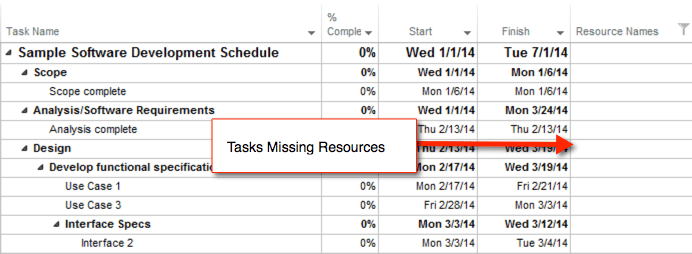
A high-quality schedule assigns all resources to the tasks in the schedule. If you’re managing cost resources separately in a spreadsheet, then I agree cost resources could be removed. Every valid task should have an assigned resource for the usual people’s “labor” resources.
Project Schedule Quality Check #11: The Missed Tasks Check
This quality check is the “late finishes” check. It identifies any task that was scheduled to be completed by the project status date and finished after the baseline finish date. These types of completed tasks are known as late finishes. The tasks were not completed on time, but they were eventually finished. Projects will have late tasks, and all of my projects have had late tasks. The key is to ensure your forecasted schedule re-aligns to the baseline schedule as closely as possible.

The Missed Task check helps determine how well the project schedule performs against the baseline. The number of missed tasks should not exceed 5% of all the tasks in the project schedule. If the metric exceeds 5%, you need to assess the schedule’s reliability and review its critical path.
Speaking of the critical path …
Project Schedule Quality Check #12: The Critical Path Check
The Critical Path Test Check assesses the project schedule network integrity by increasing the duration of a critical path task by an enormous amount. In this check, you’ll find a task on the critical path and increase the duration to 600 days. Since the task is on the critical path, you’d expect the project delay to increase by 600 days as you’ve increased the task’s duration on the critical path. The schedule passes the critical path test if the project finish date matches the added duration date finish date.
I’ve seen project schedules with multiple critical paths. You want to ensure the critical path’s integrity since you should track all tasks that form it.
Project Schedule Quality Check #13: The Critical Path Index
You can tell schedule people like math. With earned value metrics and variance calculations, it is no surprise that someone would think of the Critical Path Length Index. This index determines if the project finish date is realistic given the forecasted finish date. The critical path length index formula is calculated using the (Critical Path Length + Total Float) / (Critical Path Length) formula. Given the forecasted finish, if the value is more significant than 1.0, then the project finish date can be considered realistic.
I would look at the critical path in the project schedule and determine if the forecast meets the baseline date within an acceptable limit.
Project Schedule Quality Check #14: The Baseline Execution Index
If you like earned value, you’ll find the baseline execution index (BEI) useful. The BEI is like the Earned Value’s Schedule Performance Index as it compares the number of completed tasks to the number of tasks planned to be completed by the project status date. The BEI is the # of Complete Tasks / BEI Baseline Count and should exceed 1.0.
Wow…That’s a lot of quality checks. How can you assess all of these quickly?
I didn’t write 2000+ words to tell you about these project schedule quality checks. That wouldn’t be very tactical or nice of me!
In this article series, I’ll provide all the Microsoft Project tutorials you need to quickly interpret and assess your project schedule. By applying the techniques in this series, you can determine project schedules and identify schedule quality problems.
Microsoft Project Schedule Quality Tutorials
Tactical Project Management Project Schedule Quality Checks
- Project Schedule Quality 102: Invalid Summary Tasks Filters
- Project Schedule Quality 103: Invalid Milestone Filters
- Project Schedule Quality 104: Missing Baseline Filter
- Project Schedule Quality 105: Overallocated resource filter
DCMA Project Schedule Quality Checks
- Project Schedule Quality 106: How to Identify the Total Tasks
- Project Schedule Quality 107: Missing Logic Filter
- Project Schedule Quality 108: The Lags and Leads Filter
- Project Schedule Quality 109: Relationship Type Check
- Project Schedule Quality 110: The Hard Constraints Check
- Project Schedule Quality 111: The High Float and Negative Float Filter
- Project Schedule Quality 112: The High Duration Check
- Project Schedule Quality 113: The Invalid Dates Check
- Project Schedule Quality 114: The Missing Resources Filter
- Project Schedule Quality 115: The Missed Tasks Check
- Project Schedule Quality 116: The Critical Path Check
- Project Schedule Quality 117: The Baseline Execution Index
- Project Schedule Quality 118: Automating Project Schedule Assessment

